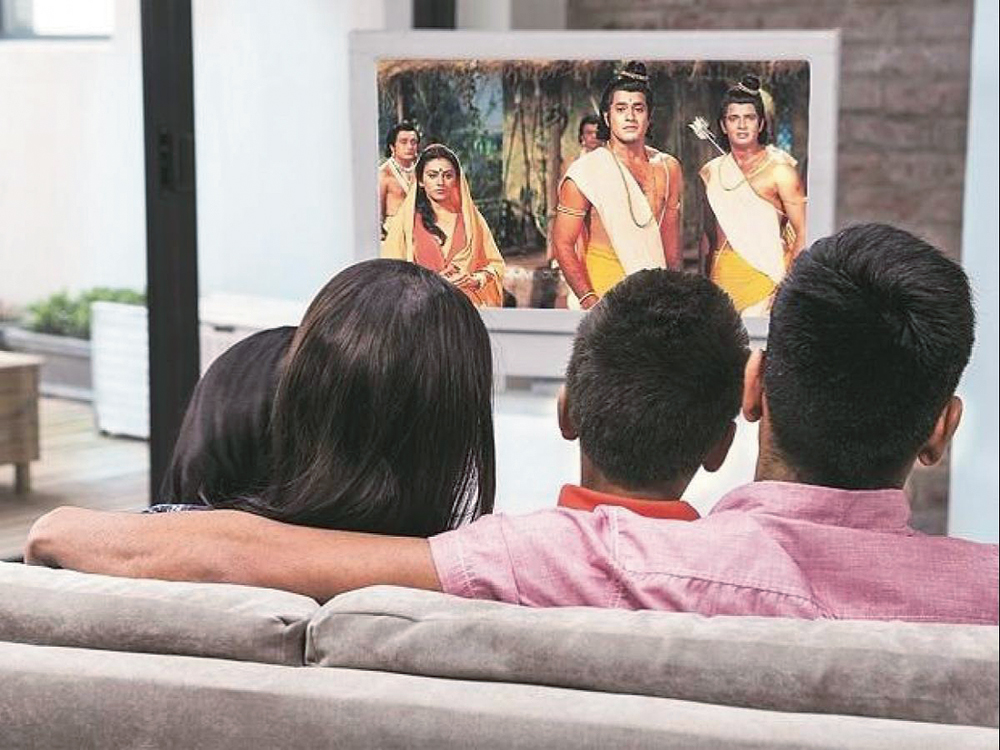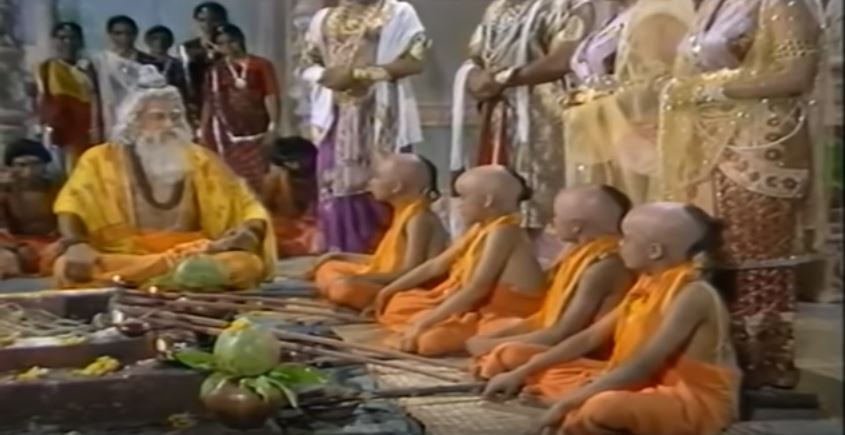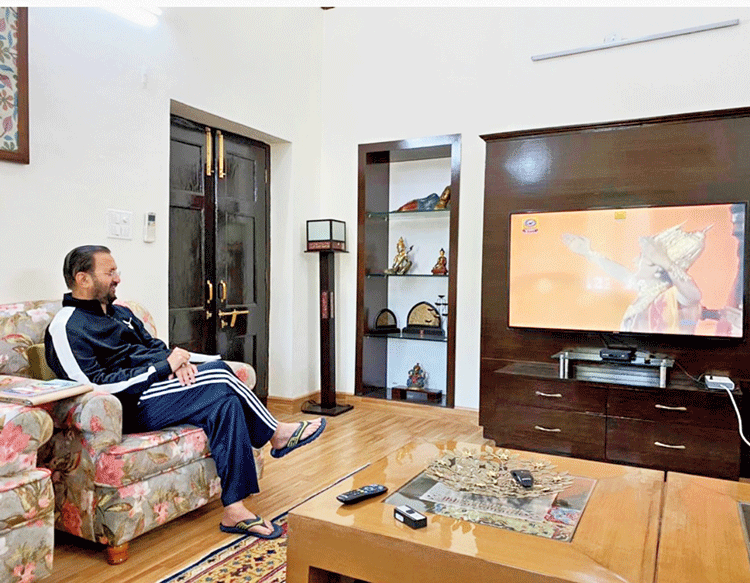Did Prakash Javadekar manage to steal a few more glimpses of Ramayan? The Union minister had tweeted an image of himself watching an episode of Ramanand Sagar’s television serial — being retelecast on ‘public demand’ — in the early days of Lockdown 1. Sadly for Mr Javadekar, India — not Lanka — went up in flames, with citizens remonstrating with the minister for choosing the epic over the government’s epic failure to rehabilitate thousands of people, mostly migrants, who had been stranded in different parts of the country on account of the prime minister’s decision to lock the country up and pocket the key.
A quick change of scene followed, with a picture of Javadekar at work replacing the one of Javadekar at play. India calmed down and went back to the screen, helping the Ramayan, aired after over three decades, to become the highest-viewed entertainment programme in the world, snatching the throne from — the irony is ‘stark’ — the Game of Thrones.
But success, the epics teach us, is often bittersweet. An advocate found fault with a heartless political dispensation feeding ‘opium’ — the television serial, presumably — to the masses at a time of great starvation and distress. The advocate earned an FIR for his tweet; thankfully, the Supreme Court stepped in to grant him protection.
It is possible that neither the sceptic nor the supporter knows a lot about the Ramayan: the televised — not textual — version of the myth. They would be able to fill the gaps in their knowledge by turning the pages of Mark Tully’s No Full Stops in India, a keenly observant and compassionate exploration of a nation caught on the cusp of unprecedented economic and political transformation. (No Full Stops, a collection of Tully’s reportage from corners of the country, was published at a time when Manmohan Singh liberalized the economy and the Bharatiya Janata Party was in ascendance on the Indian political map.) The viewers of Ramayan today, especially the millennials, would perhaps be startled to discover that the Ayodhya in the idiot box was located not in Uttar Pradesh but in Umargaon, a few hours’ drive from Mumbai where the Sagars — Ramanand, a “small, stout, bald, Pickwickian figure”, and his sons — had set up camp in a rather dilapidated studio that offered glimpses of the sea, a beach and a strip of conifers.
No Full Stops is, indeed, a mnemonic crutch. For the generation that had grown up watching — and waiting interminably — for Rama’s fire-spitting arrows — an unimpressed Tully describes them as “crude electronic tricks” — to strike down those fired at him by Ravana, the book would certainly kindle memories of not just maryada purushottam’s kindly, puffy countenance but also the signature laughter — a roar really — of his adversary. In fact, Tully, evidently, is quite taken with Arvind Trivedi — Sagar’s Ravana — whose “walrus moustache… bloodshot eyes and... pot belly”, Tully writes, compensated for the “overdone divinity of Ram”. Trivedi had other starry-eyed fans. A certain Mrs Philomena K. wrote Trivedi a letter to confide that her 82-year-old father, a Christian, had stopped watching the show after Ravana’s death; a group of women, Tully learns during the interview, had even descended on Umargaon to plead for Ravana’s life when it was apparent that Rama’s electronic arrow would — finally — reach its mark. These brief anecdotal sketches — Deepika (Sita), Dara Singh (Hanuman) also give sittings for Tully — amplify the book’s charm. Then, there is the humour. The hawk-eyed Tully spots the heat and the arc-lights taking their toll on the mighty Jambuban, who “... scratched at the furry costume… [and] During breaks... took off his claws and sipped water through a straw, unable to get a glass to his lips.”
Tully writes that Valmiki’s Ramayana is believed to be the Ur text, even though A.K. Ramanujan had dismissed this commonly-held belief in his masterful essay, “Three Hundred Ramayanas”, which demonstrated that the innumerable retellings of the Ramayana make it impossible to identify a shared textual ancestry. But the point is that many of these variants have survived and enriched South Asian culture. One possible reason for their longevity is that the Ramayana — the original katha rather than the texts, art and performances it spawned — signified a moral code to uphold one version of social cohesion and harmony; the epic is meant to function, survive, as a template of justice and order. Strikingly, over millennia, the retellings of the epic, be it in text, or during kalyug, on television, have been marked by dissenting attempts to subvert the existing pecking order. Ramanujan tells us that Vimalasuri’s Jain Ramayana, much like a Thai retelling, focuses not on Rama but Ravana; a Kannada folk version has its eye on Sita; the oral tradition of Santhals is uncharacteristically accommodating of Sita’s transgressions.
This tussle between a pater text and its radical offsprings underpins Ramanand Sagar’s Ramayan as well as Tully’s retelling of it. A dialogue between Vashisht and Rama that Tully quotes could have been a cleverly-disguised attempt on Sagar’s part to pour vitriol on the dynastic culture of Indian politics, a stick that the BJP has often borrowed to beat the Congress with. The elite — arguably the ancestors of the modern, much-reviled, liberal — receive some lusty blows from Hanuman’s mace: Dara Singh, Sagar’s Hanuman, wrestles the Westernized Indian to the mud pit, alleging that they are far removed from the Indian way of life.
But the order that Sagar and, allegedly the BJP, dreamt of resurrecting, with the televised epic doing its bit, is not indisputable. Tully devotes a paragraph to an income tax commissioner-turned film critic who, like our advocate mentioned earlier, interpreted Sagar’s Ramayan as an ingenious attempt by the government to deflect public attention from the warts that were sprouting on Ram Rajya. Another iconoclastic note, one that bridges then and now, was penned by two feisty feminists in Seminar: “Eternal mythologies like the Ramayan are revived and popularised via state controlled media at the mass ‘entertainment’ level, and the negative values they convey regarding women find more than adequate reflection in textbooks and children’s literature at the ‘education’ level.”
Mr Javadekar must pause before the Ramayan is shown a third time. An epic, every epic, endures because it is a double-edged sword. For it whispers, simultaneously, the secrets of power and resistance.












